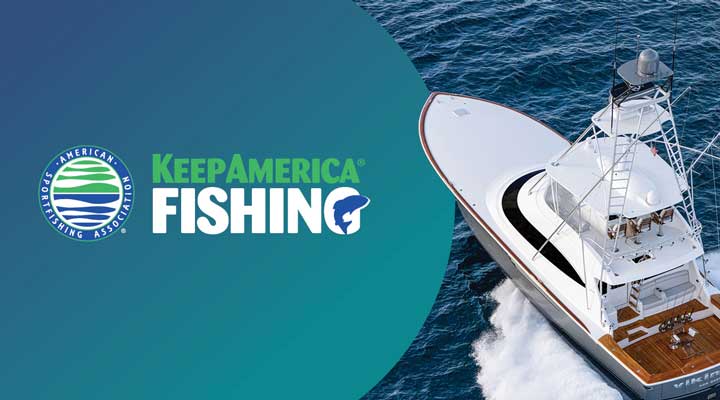Emerging research and state regulations are prompting many companies in the industry to examine the use of PFAS in their businesses. This page offers guidance and resources to help your company understand these chemicals and new regulations.
Overview of the Issue
Perfluoroalkyl and Polyfluoroalkyl Substances, or PFAS, are a family of chemicals used in a variety of everyday products, from cookware to clothing to firefighting foam. Used for waterproof, non-stick and stain-resistant applications, PFAS are often referred to as “forever chemicals,” and degrade very slowly in the environment. For more information on the impacts of PFAS on fisheries and human health, visit our “State of the Science” resource.
As the body of research grows, regulation of PFAS compounds in consumer products – potentially including recreational fishing products – is accelerating particularly at the state level.
Little information exists concerning the use of PFAS in tackle and other sportfishing products. Industry exploration into manufacturing inputs may be necessary to determine the full extent of PFAS applications in ASA member products. ASA recommends its members contact suppliers to assess whether PFAS chemicals are used in their products, and provides additional guidance and resources below.
Guidelines for ASA Members and Substitution Resources
Given the challenge of compliance with recent rulemaking and an emerging focus on the impacts of PFAS chemicals, some businesses are assessing the use of PFAS in their products and considering alternatives.
As federal and state lawmaking on PFAS continues, ASA will proactively monitor policy developments to gauge impacts on members. While ASA cannot offer its members legal services, ASA members can leverage these resources, as well as ASA staff, to answer questions and be connected with resources.
To ensure compliance in a changing regulatory climate, ASA recommends its members take the following steps:
- Engage and communicate with suppliers to gauge the use of PFAS in your products.
- Assess your company’s exposure to disclosure and phaseout requirements.
- Consider and explore chemical and material alternatives.
- Assess and inventory chemicals used in products, inputs and sub-components.
- Identify products affected by regulations and products eligible for exclusions and extensions.
- Prepare to comply with notification requirements.
- Monitor existing and potential regulations to ensure compliance and prepare for new disclosure and phaseout requirements.
WEBINARS
PFAS Reporting Requirements – Understanding Your Potential Obligations
In late 2023, the EPA finalized a PFAS Reporting Rule under the Toxic Substances Control Act. Under that rule, companies must report PFAS manufactured or imported into the U.S. between 2011 and 2022. This includes PFAS that was imported as a part of a product. Companies must undertake due diligence to search their records on the topic and ultimately report any information “known or reasonably ascertainable” to them.
With reporting due in less than a year, many in our industry have questions about this important topic. To help with this, ASA hosted a webinar on August 22, 2024 to provide our members with an overview of this important issue.
In this video, James Pollack, regulatory lawyer at Marten Law, shares his extensive knowledge of PFAS regulatory compliance at the federal and state levels.
PFAS: Understanding Current and Future Regulations, and How to Prepare Your Business
ASA hosted a webinar to help navigate the regulatory landscape around PFAS; prepare your company for compliance; and steps to explore phasing-out any of your products that might contain PFAS.
Learn More
External Resources
- BCLP Law’s guide on screening your business for risks associated with recent regulation.
- Antea Group’s PFAS Screening Tool to assess risk and develop liability management strategies.
- JD Supra’s guide on screening business risk to PFAS.
- Maarten Law’s Guide to state consumer product regulations.
- Brooks Pierce Law Firm’s article on recent rulemaking and business considerations.
Substitution Resources
The following resources offer further suggestions and options for manufacturers and industry members to consider alternatives to PFAS for use in products.
- PFAS Substitution Guide for Textile Supply Chains – Research Institute of Sweden
- The POPFREE list of Durable Water Repellence Alternatives – POPFREE
- Potential Alternatives to PFASs in Treatments for Converted Textiles or Leathers – California Department of Toxic Substances Control
- Dyeing, Printing and Finishing: PFAS – A Textiles Perspective – TextileWorld
Consumer Product Regulations
Lawmakers in several states are attempting to phase out the use of PFAS in everyday products, such as clothing, furniture and cosmetics. These laws may require companies to report the presence of PFAS in products, or may progressively phase in bans on various product categories. Some laws, including those enacted by Maine, Minnesota and California, may affect recreational fishing businesses.
Below is a list of laws and regulations that may impact ASA member businesses. As additional laws and regulations go into effect, ASA will alert our members and update the list below.
Maine PL c. 477
In 2024, Maine Governor Mills signed into law amendments to Maine’s 2021 PFAS law. These amendments withdraw much of the original law’s reporting requirements, and amend the state’s phase-out timeline. Maine’s prohibitions on intentionally added PFAS in outdoor apparel are scheduled to take effect in 2029, and in all other products in 2032.
Maine’s scheduled prohibitions also apply to products that do not contain PFAS, but are sold in containers or packaging that contain PFAS. If the DEP determines the use of PFAS in a product is an “unavoidable use,” products may be exempted from prohibitions for an additional five years.
California AB 2771
In 2022, California Governor Newsom signed AB 2771 into law, banning textiles with intentionally added PFAS, as well as textiles with PFAS above a 100 ppm concentration by 2025 and above 50ppm by 2028.
While the state Assembly and Senate passed AB 2774, a bill obliging manufacturers and other businesses to annually report on the usage of PFAS, Newsom vetoed the bill over cost concerns. Prop 65 labeling currently applies to products containing PFOS and PFOA; regulators may expand labeling requirements to other PFAS in coming years.
Minnesota HF2310
In 2023, Governor Walz signed into law new regulations mandating reporting on products containing PFAS and scheduling bans on the use of PFAS in products. By 2026, the law requires manufacturers to notify the Minnesota Pollution Control Agency (MPCA) of the presence of intentionally-added PFAS in any products sold in Minnesota. The MPCA may request manufacturers to test their products for the chemicals if it believes they may contain PFAS.
By 2025, the state will ban the sale of PFAS in several product categories, including cookware, carpeting, ski wax and fabric treatments. In 2032, the state will extend this ban to any product containing intentionally-added PFAS. The MPCA may specify products or product categories exempt from this ban, where the use of PFAS is “unavoidable.”
New York S.6291
In 2022, New York Governor Hochul signed A.7063/S.6291into law, which will ban the sale of apparel in the state of New York that contains intentionally added PFAS starting on December 31, 2023. Clothing designed for high-performance outerwear, or designed for severe, wet conditions, may not be sold containing intentionally-added PFAS beginning in 2028.
In terms of penalties, the bill requires the Department of Environmental Conservation to set a threshold for PFAS, including unintentionally added chemicals, which would take effect by 2027. Initial violations would be subject to a civil penalty of up to $1,000 a day, and continued violations would be subject to a penalty of up to $2,500 per day.
EPA Toxic Substances Control Act
In 2023, the EPA finalized PFAS reporting requirements under the Toxic Substances Control Act. The rule’s reporting obligations cover PFAS manufactured since January 1, 2011, obliging companies that have manufactured or imported PFAS and PFAS-containing articles to report information on their uses, production volumes, disposal, exposures, and hazards. EPA recently delayed the reporting deadline to January 22, 2026; small businesses meeting EPA’s criteria have until July 11, 2026 to report.
For more information, contact ASA Vice President of Government Affairs Mike Leonard.










